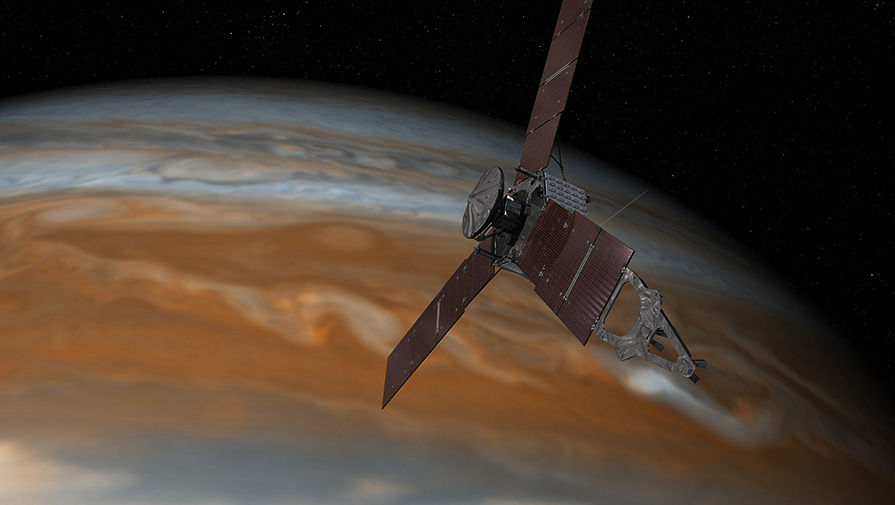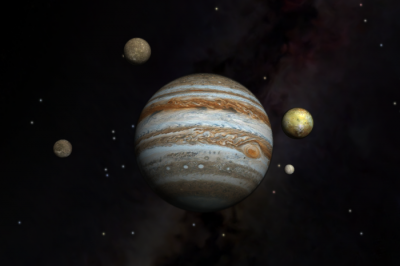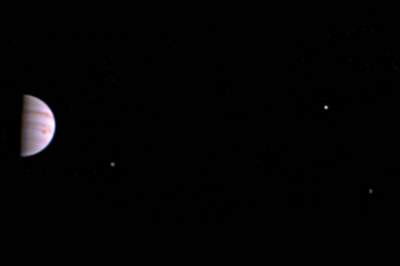Vyacheslav Avdeev
 NASAАвтоматическая interplanetary station “Juno”
NASAАвтоматическая interplanetary station “Juno”
Tomorrow, July 4, automatic interplanetary station “Juno” (eng. Juno also Jupiter Polar Orbiter) reaches the final goal of his journey lasting five years — the planet Jupiter. About the mission and the dangers that she may face, says the Department of science “Газеты.Ru”.
Jupiter is the largest planet in the Solar system. Its mass is 2.5 times the total mass of all other planets put together and 318 times the mass of Earth. The dimensions of Jupiter has a strong gravitational field, and therefore more often used by scientists to accelerate flying spacecraft using gravity assist. Just past the giant planet flew six American spacecraft (Pioneer 10 and 11, Voyager 1 and 2, Cassini and NewHorizons) and one European (Ulysses). But in orbit of Jupiter were only one automatic station — AMS Galileo.
Launched August 5, 2011 Juno interplanetary station will be the second artificial satellite of Jupiter. This is the second project in the framework of the “New frontier” space program of NASA to study the least explored areas of the Solar system.
By the way, the first mission in the program was the spacecraft “New horizons” (NewHorizons), is still transmitting to Earth remarkable images of Pluto.
“New frontiers” is the most expensive class of interplanetary missions, NASA select, on a competitive basis. The Juno mission was selected in the list from four candidates on funding, ahead of a project to deliver samples of the comet’s nucleus and the mission to study the atmosphere and surface of Venus.
30 June Juno get off the Ground, the last before the arrival of the team known as ji4040. This program runs a sequence of actions that will transfer the spacecraft from an interplanetary trajectory into orbit around the gas giant. The most important stage of these actions is a 35-minute that the main engines is scheduled for the 4th of July. Camera, breaking 2.8 billion km, finally released into orbit around Jupiter. A mistake can be expensive: Juno can just fly past the planet. Now the delay of the signal between Jupiter and Earth is 48 minutes, so the orbit will be carried out in automatic mode. The space station will have to make 37 turns around the planet, each with a period of 14 days. It is planned that each time you pass the pericenter of its orbit, Juno will include thrusters, thereby generating the adjustment.
The peculiarity of this orbit is that it passes over the poles of the gas giant. In this perspective, the largest planet of the Solar system has never seen. NASA even launched a website, where Amateur astronomers will be able to vote for the most interesting to look at their areas of the atmosphere that you want to take a picture “Juno”. After implementation of the scientific programme automatic station will be sent into the atmosphere where it will burn. Such actions, researchers hope to avoid contamination of the Galilean moons of Jupiter earth biological materials. It is expected that the mission will end in February 2018.
Another feature of the new mission is that the spacecraft uses solar panels instead of radioisotope thermoelectric generators (RTGs). They produce electricity due to heat generation by the decay of radioactive isotopes and are used for missions to the outer planets of the Solar system where solar radiation is not enough to sustain interplanetary stations.
However, due to the high cost of plutonium-238 on Juno from a similar generator was abandoned.
Electrical power to the apparatus is supplied by three solar panels with a total area of 60 sq. m. In orbit of Jupiter, “Juno” will receive only 4% of the sunlight that the camera could get on Earth. But through the use of more modern and efficient solar panels “Juno” will function normally and at a distance of 5 astronomical units from the Sun.
Despite the fact that the Jupiter study using space stations for more than 40 years, he is in no hurry to open to researchers all its secrets. One of the main goals of the Juno project will be to study the internal structure of the gas giant. Device Gravity Science Experiment (GCE) by measuring the gravitational field of the planet will give information about the distribution of the masses inside Jupiter, which in turn will help to answer the question about the presence of the massive planet’s solid core.
Another task of the mission — the study of the atmosphere. On Board microwave radiometer Microwave Radiometer (MWR), which will study the clouds of Jupiter at the depth of 550 km.
With it, the spacecraft will”see” the structure of the atmosphere below the visible cloud layer and measure the amount of ammonia and water.
Also according to him, scientists hope to understand how deeply go the atmospheric circulation that have previously discovered the Galileo probe.
Finally, Juno will investigate the gas giant’s magnetosphere. The handset has several instruments to study auroral, ion distribution of the substance at the poles and magnetic field of the planet. It is believed that deep in Jupiter’s atmosphere under the pressure of several million atmospheres, the hydrogen is compressed so much that goes into a metallic state. That is, the protons and electrons in it are separated. The resulting metallic hydrogen is a good conductor of electricity. Due to the strong currents occurring in the liquid layer of metallic hydrogen, is generated by the giant magnetic field of the planet. And it, interacting with the ions, atoms, causes the strongest auroras in the Solar system. The study of charged particles and magnetic fields near the poles and the simultaneous observation of the Aurora in the ultraviolet range will allow a better understanding of phenomena occurring in the depths of a gas giant.
The spacecraft is equipped with only one camera for shooting in the optical range. JunoCam (JCM) is a fixed three-color video camera manufactured using the same technology as the camera of the Mars Rover MARDI Curiosity.
Special scientific problems it has, and the installation was made only for the purpose of receiving “beautiful pictures”.
While still on Board the Juno is a commemorative plaque, provided by the Italian space Agency and dedicated to Galileo Galilee. Also on the unit there are three LEGO figurines: the Galileo, Roman God Jupiter and his wife Juno. LEGO figure Juno holds a magnifying glass as a symbol of the search for truth, and a toy Jupiter — lightning. Usually figures LEGO is made from plastic, but designed specifically for space mission made of aluminum so they can withstand the extreme conditions of flight.
During operation in orbit around Jupiter, Juno will be exposed to serious danger. The gas giant has powerful radiation belts. Each time you pass the belts automatic station experiences the impact of the stream of charged particles that it poses a risk for the onboard electronics.
It is known that the closer to Jupiter of the spacecraft Galileo received a dose of radiation 25 times higher than the lethal dose for humans.
This explains the relatively short by modern standards, the duration of the mission.
Interestingly, the machine Juno was given the name of the Roman goddess Juno, the wife of the God Jupiter (the Roman version of the Greek Zeus). Thus the Galilean satellites of Jupiter (IO, Europa, Ganymede and Callisto) are named after the lovers of Zeus from Greek mythology (Ganymede — lover). In the poem Roman poet Ovid’s “Metamorphoses” is the moment where Jupiter envelops itself in a cloud, trying to hide their not very plausible things from his wife. But Juno finds out about it and ordered the clouds to disperse.







